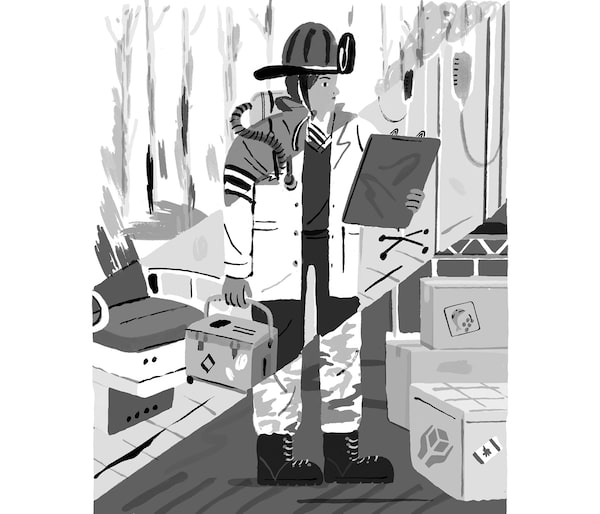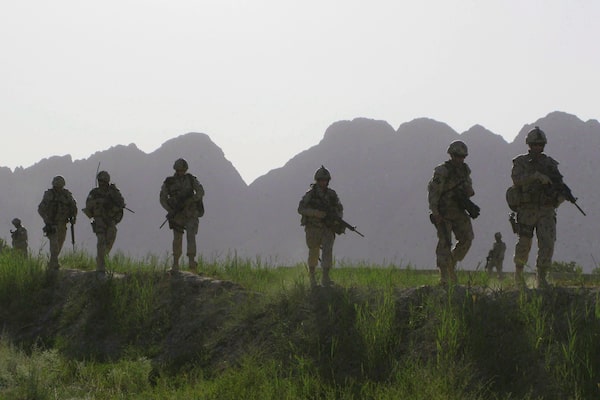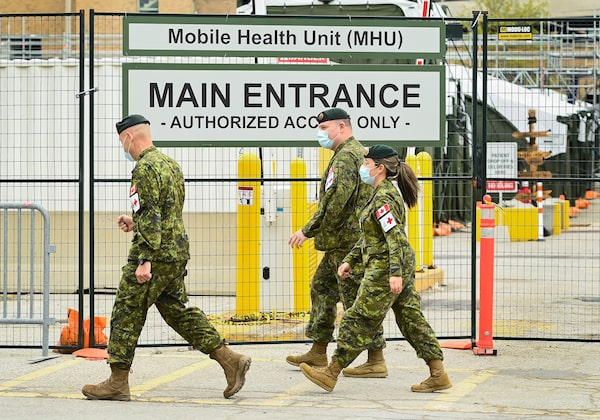
Illustration by Tallulah Fontaine
Kevin Patterson is a physician, essayist and novelist. He practises general internal and critical care medicine on Vancouver Island and on the west coast of Hudson Bay.
This month has brought us face-to-face with two history-defining events: U.S. President Joe Biden’s announcement of the upcoming withdrawal of the last American troops from Afghanistan, and the four-millionth reported death from COVID-19. The pandemic and the Global War on Terror are the defining catastrophes of the early 21st century. Each has been characterized by incompetence and misjudgment in its management and much blame has been thrown about. More will follow as these events are digested in the years to come. But beyond the limited satisfaction of retrospective blaming, there is an insight to be gained from these fiascos: War is no longer the horseman we need to worry most about. The pandemic has shown us that we face other, far greater threats than of invasion; it and others demand the same seriousness of purpose, the same preparedness and the same national resolve that we summon so easily for war.
If a threat appears in the form of what is deemed to be an armed aggressor, Western countries can summon enormous resources almost instantaneously and will be, almost without debate, prepared to pay the incalculable price of casualties. Within weeks of 9/11, America had Special Forces on the ground in Afghanistan, preparing to oust the Taliban. Over the next two decades, America spent US$2.2-trillion there. Two thousand three hundred and twelve dead. Twenty thousand with visible wounds. Canada spent at least $18-billion on its own mission in Afghanistan. One hundred and fifty-eight soldiers dead. Two thousand with recognized wounds.
Soldiers carry the coffin of a fallen Canadian comrade, Master Corporal Mario Mercier, at Kandahar airfield in 2007.Martin Ouellet/The Canadian Press
To preserve the capability to undertake the sort of mission it accepted in Kandahar -- the only sustained shooting war Canadians have fought since 1953 -- Canada has spent about 1 per cent to 1.5 per cent of its GDP per year on defence ($20-billion in 2021) since the end of the Korean War. In contrast, COVID’s arrival saw Canada with no domestic vaccine production capability, and such limited stocks of personal protective equipment that by May, 2020, what we wore in my hospital was scarcely distinguishable from garbage bags -- and we came close to running out of those entirely. In New York, health care workers were reduced to wearing actual garbage bags. The American defence budget is more than US$720-billion; the U.S. Navy maintains 10 carrier strike groups, any one of which would be the world’s second most powerful navy, if it belonged to another country. When I was in Kandahar, expense was no object to anything. It cost the Americans US$1-million per soldier each year to keep them in-country.
Twenty-six thousand Canadians have been killed by COVID-19 in 16 months. During the Second World War, we lost 45,000 in six years. Globally, the war killed 75 million. The Spanish Flu killed between 50 and 100 million people. Between 1990 and 2019, 32.7 million died of HIV. Even in the homicidal spasm that was the 20th century, pandemic was a greater threat than war; today, for Canada and rich countries more generally, it isn’t even close. And there are certainly more COVIDs to come. If SARS had truly broken out the way COVID did, it might have killed 10 times as many -- its case fatality rate was 10 per cent. (Its own virulence made it more controllable. The sick were quickly too unwell to circulate; asymptomatic viral shedding was less common.) Pandemic influenza has come at roughly 40-year intervals since the 1500s. There are avian influenza strains in Asia such as H5N1 with 60-per-cent case fatality rates in humans. (Again, the virus awaits a reduction in the immediate virulence to become maximally dangerous.)
Marjory Robert holds a photo of her late husband, Gilles, a COVID-19 victim, at a 2020 vigil at the Orchard Villa retirement home in Pickering, Ont.Melissa Tait/The Globe and Mail
But other non-infectious threats also hover: There will be a catastrophic megathrust of the Juan de Fuca Plate. In May, cyberattacks closed down the Colonial pipeline along the American Atlantic Seaboard, prompting a fuel crisis that had desperate people filling plastic bags with gasoline and putting them into their car trunks. The hackers were paid US$5-million to restore its code. Meaning: they’ll be back. No organization is safe. There have been successful ransomware attacks on hospitals and schools. In 2019 there were at least 205,000 organizations subjected to ransomware attacks, a 41-per-cent increase from the year prior. By the end of 2019 the average payment to the hackers was US$190,000. The extent of Russian hacking in the Brexit debate and referendum, to say nothing of the American and Canadian elections remains uncertain. But the motivation to skew those results exceeds $190,000 by a considerable margin. There was even, shockingly, Russian hacking of COVID vaccine trials.
The forests of the continent burn more extensively every summer as the Earth warms. The Boreal Forest, the largest on Earth, gets more vulnerable with each hotter and dryer August. In 2016 fire leapt from it to nearly envelop Fort McMurray. Recently, the town of Lytton, B.C., was burned to the ground, after temperatures there set a Canadian record 46.6 C under an unprecedented heat dome affecting Western Canada and the U.S. Sixty per cent of the country is covered with standing, drying and resinous, jack pine and black spruce.
A building in Lytton, B.C., lies in Ruins on July 9, just over a week after a devastating wildfire.Jackie Dives/The Globe and Mail
We need to be prepared for these threats. In an emergency we need to have the capacity to respond powerfully, to quickly put people on the ground the way the military did in Afghanistan, but to: do contact tracing, bring food to the quarantined, dig out trapped people under buildings, fight fires, construct both fire breaks and fire walls, clean up oil spills, go to and assist the addicted, and intervene in suicide epidemics and housing and water crises in Northern and remote communities. These are the sorts of current, continuing and predictable threats we face.
Instead the eye is always drawn to -- anticipates, in some circumstances, even delights in -- violence. Deep in our brainstems, we seem wired to be more concerned with homicide than with famine or pestilence or any other threats. There would never be Greek heroic epics devoted to the Athenian Plague, but the one about the siege of Troy remains canonical. First-person video games, even in 2021, are not concerned with shooting vaccines into anyone. The ethos dulce et decorum est pro patria mori (how sweet and proper it is to die for one’s country) runs through classical literature and the daughter democracies of the West have never shrugged off these ideas, notwithstanding Wilfred Owen. During the SARS outbreak in Toronto in 2003, ICU nurses in one hospital incurred a 6-per-cent chance of being infected -- with a 10-per-cent risk of dying -- per shift worked. There were no movies made about them. Meanwhile, Clint Eastwood’s American Sniper (concerning the most lethal sniper in American history with a self-proclaimed 244 distanced kills) was one of the highest grossing films of 2014.
The pandemic brought to America, briefly, a preoccupation with toilet paper supplies; a more enduring effect will not be fastidious handwashing or face mask wearing -- which was rejected by a sizeable minority anyway -- but the sustained surge in gun sales, which were up 18 per cent in the first quarter of 2021, compared with the previous year. A fifth of these weapons were sold to first-time buyers. And those buying weapons as a response to pandemic-related anxiety seemed to broadly overlap with those most hostile to public-health measures and mask-wearing. Any sort problem appears and something deep in the human brain wants to interpret it firstly through the lens of violence.


What a difference a decade makes: At top, Canadian soldiers patrol an area in southern Afghanistan's Dand district in 2009, and at bottom, military health personnel walk by a mobile health unit at Toronto's Sunnybrook Hospital in April of 2021.Nathan Denette/The Canadian Press
I once trained as an infantry officer. Later I served as the regimental medical officer in an artillery battalion. In this time, I came to admire greatly the soldierly ethos of readiness, mobility and service, and especially the preparedness for self sacrifice. To ask women and men to spend their working lifetimes learning skills they will rarely ever practise is a daunting request. To submit to the rigorous discipline of military life, with its rigid rank structure and its own, more expansive and punitive justice system is another daunting request. But our unparalleled request of the military is our expectation that soldiers will run toward danger, to consider duty more important than their own safety, their own lives. We can question the amount of money spent on “defence,” and we can be wary of the bellicose and authoritarian political influence of generals, but the code that their soldiers subscribe to and attempt to live by is only admirable.
And it offers instruction for how a different Department of National Safety, subsuming DND, and more concerned with resilience than lethality, might look. Contemplate battalions of workers -- not a Canadian Corps of Army Engineers -- taking an F-35 or two worth of money and erecting housing in the North and other housing insecure parts of the country and fixing water purification systems. Platoons of public-health nurses in the Arctic, working to finally gain control of tuberculosis, which persists at a rate 290 times (2018 data) that of the South, when they aren’t responding to outbreaks of E. coli or meningitis or opiate overdoses. Disaster response would not be a diversion for those sent to earthquake sites, floods and forest fires, but their primary profession: They would train in fire fighting, resuscitation, dog handling, stress counselling and logistics. They would be multilingual and comfortable in unfamiliar cultures. When tsunamis and earthquakes strike desperate places, they could be counted on to be among the first to help. As non-soldiers, they might work for and learn from NGOs such as Médecins sans frontières. Software engineers would monitor and develop countermeasures against ransomware attacks and other hacking; vaccinologists and epidemiologists would attend to future pandemic threats and work intimately with and be seconded to the long-underfunded and derided World Health Organization, which would conduct a continuing and resourced assessment of the risks of climate change. Some of these personnel would possess skill sets that look a lot like those of soldiers. But those skills would be subsidiary to the larger goal of national safety and the real threats to it.

A Canadian soldier helps a resident of Montreal's Vigi Queen Elizabeth long-term care home in May of 2020.GENEVIEVE BEAULIEU/Canadian Armed Forces/AFP via Getty Images
The military as it exists has been used for civil assistance missions in the past, and Canadian Forces personnel have acquitted themselves admirably, especially during the COVID crisis in long-term care homes, where they served both as caregivers and, courageously, as whistle-blowers. But no soldier sees civil assistance missions as being her primary role. They are the wrong tool for the job. The head of the army is always a combat arms (infantry, artillery or armoured) officer; the Chief of the Defence Staff is one of these, or a combat pilot or naval deck officer, never a nursing officer or even an intelligence officer. “Operators” is the term used for those who do the wet work. The military as it exists is mostly for killing people.
Overfunding such an organization is dangerous as well as wasteful; idle hands find reasons to act. Canadian generals lobbied hard to get Canada to take on the Kandahar mission. If generals have to talk politicians into making war, the seeds of disaster are already planted. And it was a disaster. I was there. The parents of the shattered children who came to the hospital at KAF did not look at us with gratitude. They loathed those who had brought about the occupation that led to the shattering. If the locals were as supportive as military PR insisted they were, then how did the Taliban move so easily among them and prosper? It was all a fantasy. Cultural change at gunpoint: the next time that works will be the first. Generals pushed weak politicians into it and it was a fiasco. Think what could have been done for pandemic preparation with the $18-billion we spent on that mission. And for TB eradication. And for clean water for the First Nations.
Militarism is a cancer in the U.S. and every other secure country that buys into the idea that war is every country’s principal threat. Even in Canada, “defence” represents the largest discretionary line item in the federal government’s budget.
An old way of imagining a country is that it is embodied by its military: the Royal Navy, the Red Army, the Wehrmacht, the Marine Corps. National economies served to fund them, and if they were not funded, then stronger armies would take what they wanted. As Prussia took the Alsace and Lorraine. But that was the last time a major power has initiated war against another and obviously profited. That was a century and a half ago. Now China threatens to eclipse the U.S., and the eclipsing will be entirely economic; the trillions spent on the Afghanistan and Iraq wars have hastened America’s relative decline in prosperity and stature. Twelve thousand, five hundred dollars per person those wars cost them. Thirty-six thousand dollars per family. What did it buy them? Torture. Gitmo. Declining infrastructure and abysmal public education. The underfunding of American public education has much to do with the conspiracy theories and science skepticism that played a role in the disastrous death tolls on this side of the Pacific. The relatively weak social safety net in the U.S. means that the poor there are poorer than members of the richest country on Earth should be, and the poor died there, as they always do in epidemics, in droves and in proportion to their poverty.

A registered nurse speaks to a patient at the COVID-19 intensive care unit at B.C.'s Surrey Memorial Hospital this past June.Jonathan Hayward/The Canadian Press
I attend in the intensive care unit in Nanaimo, B.C., on Vancouver Island. Our COVID crisis was more modest than that of the rest of non-Atlantic Canada. But nearly the full weight of it fell on Indigenous people. Though Indigenous people represent a small minority of the population of Vancouver Island, they were a clear majority of our dead. Poverty. Crowding. Social determinants of health -- as the academics dryly put it.
I have also worked for 25 years in Kivalliq, the west coast of Hudson Bay, in Nunavut. My brother Michael, of whom I am immensely proud, is the Chief Medical Officer of Health of Nunavut and has directed the pandemic response there with great skill. With aggressive public-health measures initially, and then subsequently with accelerated vaccine delivery, the catastrophe I and other Nunavut physicians anticipated was forestalled; catastrophe would have only recapitulated the experience with tuberculosis, measles, polio, meningitis and lung infection -- it seemed for a long time unavoidable. But catastrophe did not come. Some of this, my brother says, was simply good luck.
That vulnerability is poverty and crowding. As my brother has stated about tuberculosis, “We’re going to have to decide if we’re going to be able to make the interventions necessary to eliminate the housing shortfall to fix the food insecurity, because that’s a much bigger problem.” I work regularly in Naujaat and Arviat, at the northern and southern ends of the West Coast of Hudson Bay. In these communities, there are often more than 15 adults living in a three-bedroom house. 3,545 families in Nunavut, in a population of 38,780 are without shelter. They couch surf. In the Arctic. Imagine it.
The Inuit dodged a bullet with COVID. It could have been so much worse. But it was still awful, for the Indigenous people and for the country. Nothing has hit Canada harder in several lifetimes. And when it hit we were almost entirely unprepared. Only the miraculously rapid development of vaccines has saved us from profound social disruption. Our vulnerabilities are made clear. We must address them. And guns won’t help.
We have an opportunity now to clarify our thinking around the risks we face and their relative magnitude. Violence terrifies and activates us and so we have devoted disproportionate resources to it. For the moment, we understand the pandemic to be as dangerous and as terrifying as it really is. There are other threats as serious. We should take advantage of our recent difficulties, our recent fear, to help us think more clearly about where and how many resources we should devote to preventing the chaos of the last year from being repeated.